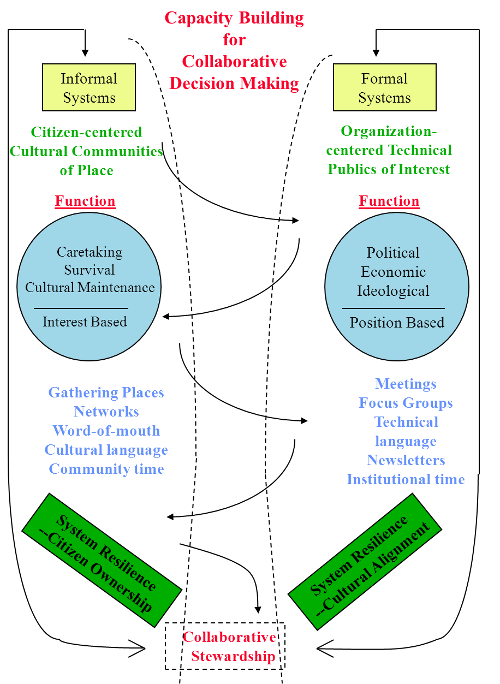
Project managers work to manage many kinds of risk: risk of financial loss, legal risk, technical risks, and many more. CSEPP facilitates managers in considering another kind of risk–social risk. When citizens oppose any aspect of a project for any reason, the risk of opposition and disruption to effective project implementation is increased. Just as financial risk can be managed by careful budgeting, continual expense monitoring, etc., CSEPP has developed a robust model for addressing the social risks associated with a project or program.
Examples of sources of social risk
- Unaddressed citizen issues related to a project which become disruptive
- Incongruity between the a dimension of a community’s culture and management’s approach to project design and implementation
- Exclusion of an important sub-group of citizens (which we call “publics”) from a project’s planning or implementation process
- Lack of meaningful communication between project managers and community members
The diagram on the left depicts the interaction between the formal and informal systems that exist in any community. (Read more about the interaction between these systems in our formal vs. informal systems theory page.) These two systems are always interacting with one another, in both straightforward ways and through more nuanced pathways. For example, a formal system such as a local government is responsible for allocating tax dollars among many programs and projects. A decision to reduce the budget of a subsidized housing program, for example, impacts the functioning of informal care taking systems within a community. The social risk involved in this interaction stems from the possible misalignment between the way citizens attend to one another’s needs and the approach the formal government personnel use to coordinate institutional support services.
Perhaps government decision makers decide–with limited information about how the informal systems functions–that the most appropriate area for a budget reduction is to increase the caseload of housing coordinators. This decision involves high social risk because it was made without grounding in the informal culture of a community. With more attention to creating meaningful communication and collaboration pathways with citizens involved in public housing, local government officials may have discovered that housing residents are open and willing to take on certain facility management duties that are currently carried out by paid staff–such as grounds maintenance. By searching for opportunities for collaboration in the budget reallocation process through the discovery process and taking a graduated approach to citizen engagement, local government managers could have discovered that the maintenance budget could be reduced and coordinate case loads remaining at their previous levels. A collaborative approach presented in this example shows how social risk can be “managed” by considering alignment between formal and informal systems.
James Kent, Senior CSEPP strategist, describes the imperative for careful management of social risk in an article published in the International Right-of-Way Association magazine:
By addressing community-related issues that cause excess budget over-runs and project schedule delays, the team would be responsible for understanding the community’s concerns and taking a proactive approach to preventing project disruption by assisting citizens to participate in, predict and control their environment. The social risk has become too great to not formally recognize and systematically act upon the underlying causes of how and why citizens go from potential healthy participation to organizing to fight a project. Regardless of whether the project is on public or private land, today’s projects require and deserve this level of attention.
Related articles
Formal vs. Informal Systems
Managing Social Risk (Publication: IRWA Magazine, Jan-Feb 2013)
Community Network Structures

